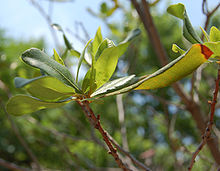- Myrica pensylvanica
-
Myrica pensylvanica 
Scientific classification Kingdom: Plantae (unranked): Angiosperms (unranked): Eudicots (unranked): Rosids Order: Fagales Family: Myricaceae Genus: Myrica Species: M. pensylvanica Binomial name Myrica pensylvanica
MirbelMyrica pensylvanica, the Northern Bayberry, is a species of Myrica native to eastern North America, from Newfoundland west to Ontario and Ohio, and south to North Carolina.
Myrica pensylvanica is a deciduous shrub growing to 4.5 m tall. The leaves are 2.5-7 cm long and 1.5-2.7 cm broad, broadest near the leaf apex, serrate, and sticky with a spicy scent when crushed. The flowers are borne in catkins 3-18 mm long, in range of colors from green to red. The fruit is a wrinkled berry 3-5.5 mm diameter, with a pale blue-purple waxy coating; they are an important food for Yellow-rumped Warblers.
This species has root nodules containing nitrogen-fixing microorganisms, allowing it to grow in relatively poor soils.
Uses
The berries can be used to make bayberry wax candles. American colonists boiled the berries to extract the sweet-smelling wax, which they used to make clean-burning candles.[1][2]
Bayberry essential oil, extracted from the aromatic leaves, is used to scent many products. Bayberry essential oil is moderately toxic due to a high eugenol content.[3]
References
- ^ Mark H. Brand. "Myrica pensylvanica: Northern Bayberry". Plant UConn Database of trees, shurbs and vines. Retrieved 2010-10-29.
- ^ "History of Candles." National Candle Association (2010). Retrieved 2010-10-29.
- ^ "Bayberry Oil (Fragrance)" Xenex Labs Inc. (2005). Retrieved 2010-10-30.

This Fagales article is a stub. You can help Wikipedia by expanding it.

